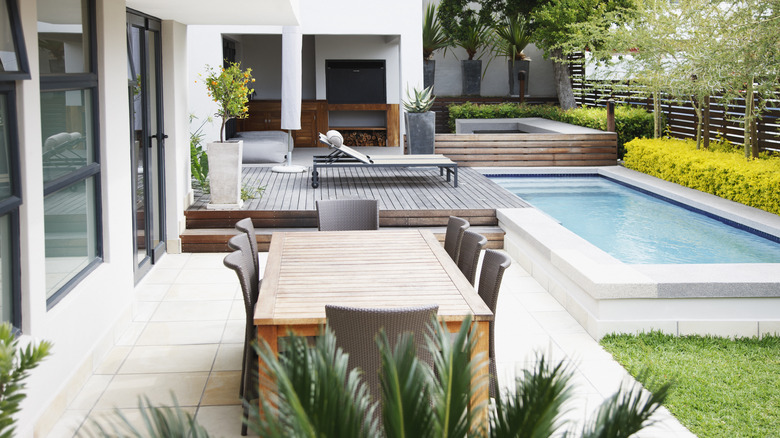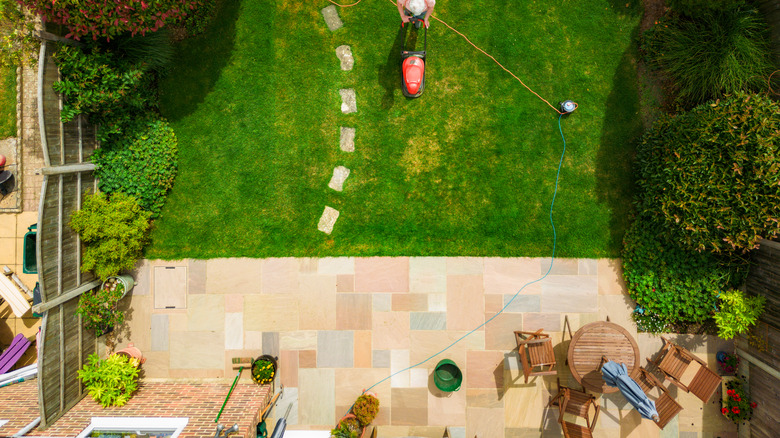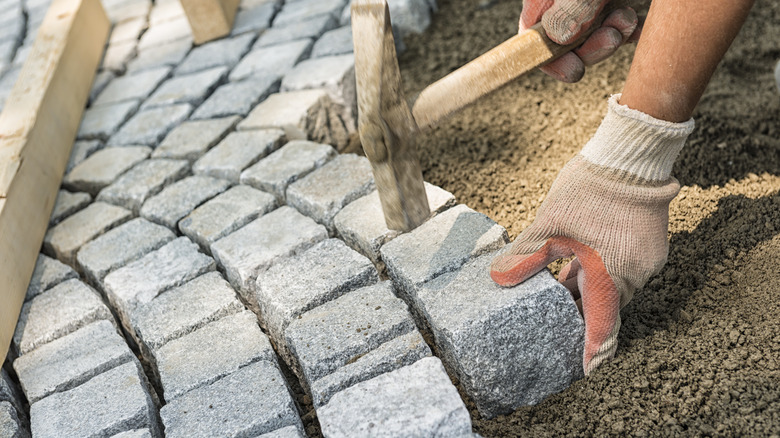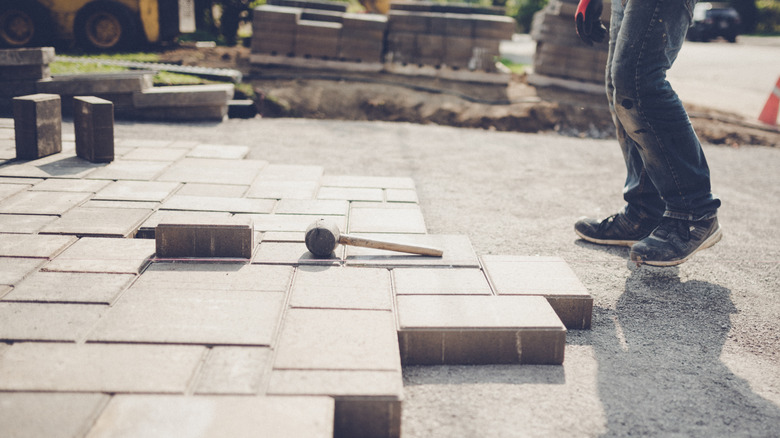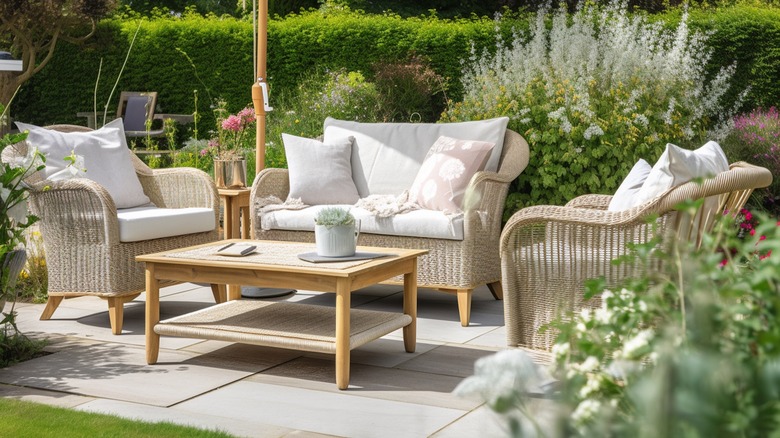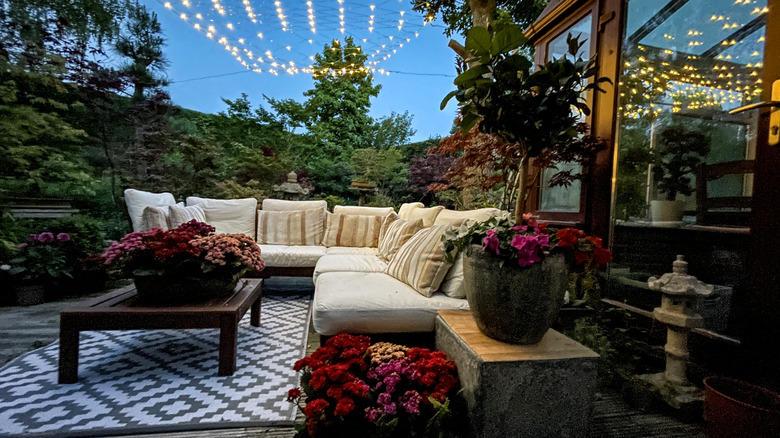The Best Quality Material For A Patio If You're On A Tight Budget
Patios can elevate a garden. However, when planning a patio, the choice of material is crucial to both the functionality and aesthetics of the space. The most popular materials used for patios include brick pavers, natural stones, and concrete. Each of these materials offers distinct advantages and suits different design preferences and budget considerations. Brick pavers are known for their classic look and versatility, making them a favorite for traditional and modern designs alike. They come in various colors, shapes, and sizes, allowing for creative patterns and designs. Their durability and ease of maintenance make them a practical choice for high-traffic areas.
Natural stones, such as flagstone and slate, provide a timeless, elegant appearance. They come in various shades and textures, adding a sophisticated touch to any outdoor space. However, John De Luca, the co-owner of A De Luca Paving, told Outdoor Guide that natural stones are generally more expensive due to the processes involved in quarrying and cutting them to size. They are also heavier and more challenging to install.
Concrete is a cost-effective option that can be customized with various finishes and colors. It can be stamped, stained, or textured to mimic more expensive materials like stone or brick, offering versatility in design at a lower cost, according to De Luca. Concrete patios are durable and can withstand extreme weather conditions, making them suitable for various climates.
Comparing the cost of patio materials
Cost is a significant factor when selecting patio materials. Natural stone is generally the most expensive option, with a price tag at around $6 or more per square foot. "Since they are quarried and saw cut to dimension, they're usually on the top end of the cost scale," De Luca explained to Outdoor Guide. Despite the expense, many homeowners choose natural stone for its unmatched beauty and long-lasting durability. It can significantly enhance the aesthetic appeal and value of your home.
Concrete, in contrast, is the least expensive material, typically costing about $2.50 per square foot for a standard 4-inch thickness, according to De Luca. This affordability makes concrete a popular choice for budget-conscious homeowners looking to create a functional and attractive patio space without spending a fortune. Concrete can be poured in large sections, which helps to speed up the installation process and reduce labor costs.
Brick pavers fall in the mid-range, depending on the quality and style. As De Luca noted, "Good quality decent bricks costs $3 and up per square foot." They offer a good balance between cost and aesthetics. Brick pavers are available in various grades and finishes, which can affect the overall cost. Higher-quality pavers will cost more but offer greater durability and a more polished look.
Can you do it yourself?
For DIY enthusiasts, the ease of installation is a critical consideration. Concrete is the most challenging material to work with. As De Luca explained to Outdoor Guide, "You only have one shot of doing it right. It requires very skilled workers to place it and finish it properly," adding, "It's not something for a DIYer." Mistakes can be costly and difficult to fix once the concrete sets. The process involves mixing, pouring, leveling, and finishing the concrete, which needs to be done quickly and efficiently to prevent it from hardening unevenly.
Natural stones also present challenges due to their varying sizes and the need for precise cutting and placement. Stones must be carefully selected and fitted together like a puzzle to create a stable and attractive surface. "It requires more skill to be placed properly," noted De Luca. The weight of natural stones can also make the installation process physically demanding, requiring special tools and expertise to handle correctly.
Brick pavers, however, are the most DIY-friendly option. They are manageable in size and weight, and errors can be easily corrected by resetting the pavers. The installation process for brick pavers involves laying a base, spreading sand, and placing the pavers in the desired pattern. It's a relatively straightforward process that doesn't require specialized skills or tools.
How to prepare the sub base
Regardless of the material chosen, proper preparation of the sub base is essential for a successful patio installation. This involves laying out the area and excavating to a suitable depth to reach stable soil. A minimum of 6 inches of crushed stone base is required to ensure stability and proper drainage, De Luca told Outdoor Guide. This crushed stone base helps to prevent shifting and settling over time, providing a solid foundation for your patio.
For brick pavers and natural stone, a 1-inch layer of coarse sand is added on top of the crushed stone, De Luca told Outdoor Guide. The sand layer provides a smooth and level surface for the pavers or stones to rest on, making it easier to achieve a uniform finish. The sand also helps to lock the pavers in place, preventing them from moving or shifting.
"All three materials require the same amount of planning for proper surface drainage to allow for at least 1% pitch away from the structure and directed to an area of positive drainage," explained De Luca. Proper drainage is crucial to avoid water damage to your home and the patio itself. Water that doesn't drain properly can lead to erosion, mold, and other issues that can compromise the integrity of your patio. Compaction of the sub base material is crucial to avoid future settling and maintain the patio's integrity. A compacted base provides a stable foundation that can support the weight of the patio materials and any furniture or equipment placed on top.
Getting the best bang for your buck
When it comes to getting the best value for your investment, brick pavers stand out as the top choice. They offer a balance of affordability, ease of installation, and aesthetic appeal. De Luca also offered up some alternatives, revealing, "You could use timbers or some decorative gravel as well, but both require a lot of maintenance." Brick pavers provide durability and can be easily repaired or replaced if needed.
Another advantage of brick pavers is their longevity. They are resistant to cracking and can withstand heavy foot traffic and extreme weather conditions. Unlike concrete, which can crack and require costly repairs, individual brick pavers can be easily replaced if damaged. If the patio gets dirty, try using dishwasher soap to clean it.
Furthermore, brick pavers are environmentally friendly, as they are made from natural clay and can be recycled. This makes them a sustainable option for eco-conscious homeowners. Overall, brick pavers provide the best bang for your buck, offering a durable, attractive, and cost-effective solution for your patio project.
Making the most of your patio
As De Luca perfectly puts it, "Patios are no longer just patios anymore." He added, "They have evolved into complex and sophisticated outdoor living spaces." This evolution emphasizes the importance of choosing durable and versatile materials that can accommodate various features and withstand the elements.
Investing in quality materials like brick pavers not only enhances the functionality of your patio but also adds value to your home. A well-designed patio can serve as an extension of your indoor living space, providing a comfortable area for relaxation, dining, and entertaining. Features like built-in seating, pergolas, and outdoor lighting can transform your patio into a multi-functional space that meets all your outdoor living needs. Light up your plants with this handy DIY trick and make sure you follow these tips to keep your patio furniture protected in the winter. With the right materials and design elements, your patio can become a true outdoor oasis that enhances your lifestyle and increases the value of your home.
